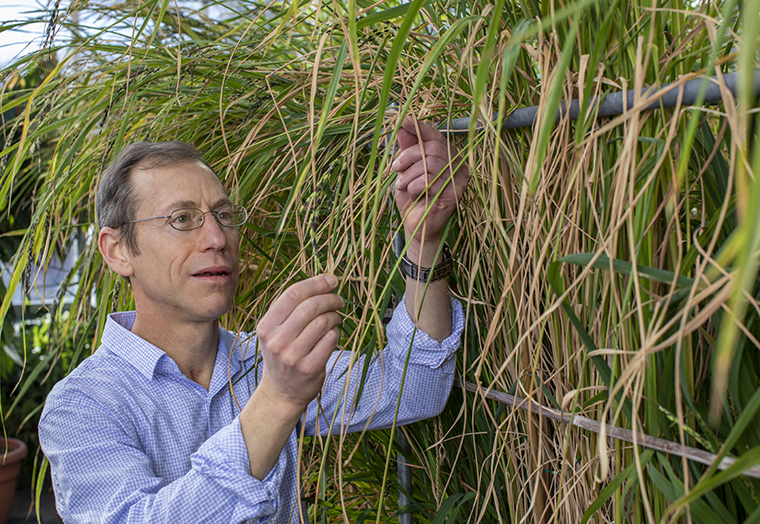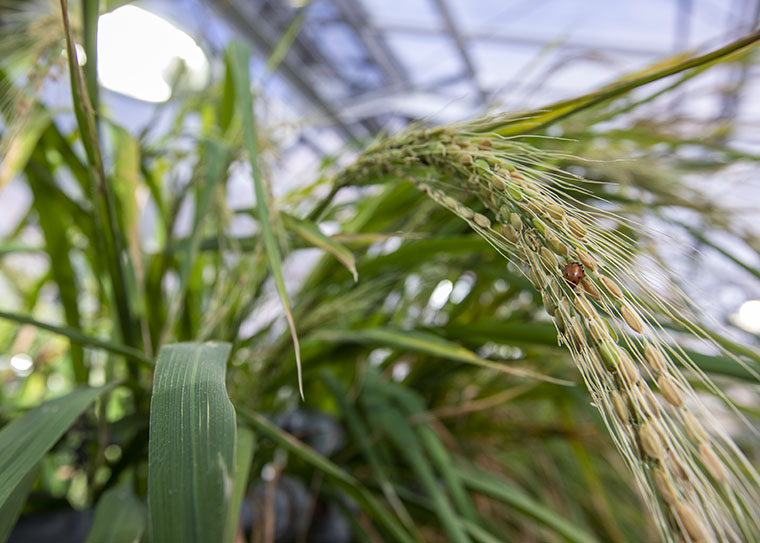In a paper published Sept. 8 in the journal Communications Biology, scientists from Washington University in St. Louis and the University of Arkansas report that a crop pest called weedy rice has become widely herbicide resistant in regions where herbicide-resistant rice is planted. The study highlights challenges facing U.S. rice farmers when they battle a weedy enemy that is closely related to a desirable crop plant.
The genetic investigation was conducted with samples gathered in rice fields in Arkansas, where almost 50% of the nation's rice is grown.

Weedy rice is a closely related cousin of crop rice. It aggressively competes with cultivated rice in the field, leading to loss of yield and reductions in harvest quality that compromise market value. Weedy rice infestations cause an estimated $45 million in economic losses in the United States each year and hundreds of millions of dollars worldwide.
Biologists used whole-genome sequences of 48 contemporary weedy rice plants to show how herbicide resistance evolved by gene flow from crop rice. Almost all other cases of herbicide resistance in agricultural weeds result from selection of tolerant genotypes in the weed species. Just 20 years after herbicide-resistant rice was first adopted in the southern United States, the majority of fields with a history of herbicide-resistant rice cultivation have weedy rice plants that are also herbicide resistant.

"Throughout its nearly 200-year history in the United States, weedy rice had a very low rate of outcrossing with cultivated rice," said Marshall Wedger, a postdoctoral research associate in biology in Arts & Sciences at Washington University and first author of the study. "We found that U.S. weedy rice has persisted through herbicide pressure with the survival of those few plants that outcross, consequently acquiring the herbicide- resistance trait."
"Technological changes in U.S. rice farming since the 2000s have led to a complete genetic revolution in the makeup of the weedy rice that infests U.S. fields," said Kenneth Olsen, professor of biology at Washington University and senior author on the study.
"In the last 20 years, weedy rice has gone from being very genetically distinct from U.S. crop varieties to nowadays mostly being derived from crop-weed hybridization," Olsen said. "The weeds are grabbing certain traits from the crop that are beneficial to them, including herbicide resistance."
Weeds seize their moment
Weedy rice is a scourge of cultivated rice production around the world. But up until the early 2000s, weedy rice in U.S. fields rarely interbred with the kinds of rice that were commonly grown in this country.
Crop rice and weedy rice are the same species, so they are able to interbreed, or hybridize. Their rate of hybridization rate is usually low — generally less than 1% — because rice is self-pollinated.
But something happened that changed the centuries-old dynamic between these two closely related plants. Starting in the early 2000s, two new kinds of crop rice were adopted in U.S. fields. One was a new hybrid rice that offered substantially enhanced yield, compared with traditional inbred (self-pollinating) rice cultivars. The other was a new kind that had been tweaked to be tolerant to a certain kind of herbicide. These so-called Clearfield™ cultivars allowed farmers to plant rice and then apply chemicals to their fields to kill weedy rice and other agricultural weeds without harming the crop.
As early as 2004, just two years after the new rice was adopted locally, Arkansas farmers already were reporting some cases of herbicide resistance in weedy rice. Such resistant plants were likely outcrosses with herbicide-resistant rice.
"The situation is somewhat analogous to human health and the emergence of antibiotic-resistant bacterial pathogens. Widespread use of antibiotics ends up strongly selecting for the rapid evolution of the drug-resistant strains," Olsen said. "With weedy rice, herbicide-resistant weeds were being detected just a couple of years after herbicide-resistant rice was first commercialized."
How did it happen? For gene flow from a crop into a weedy relative to occur, the two have to be growing in close enough physical proximity for pollen transfer.
"The herbicide-resistant weedy rice plants are the products of outcrossing with herbicide-tolerant crop," said Nilda Roma Burgos, professor of weed physiology at University of Arkansas and a co-author of the study. "Outcrossing occurs when weedy rice is not controlled 100% by the herbicide and the remaining weedy rice plants flower at the same time as the herbicide-tolerant rice crop."
Rice and weedy rice certainly grow in the same fields. However, it was the hybrid rice's pesky habit of producing volunteers — that is, successfully developing and dropping seeds that overwinter and then emerge as new plants in subsequent years - that opened a door for weedy rice.
The crop volunteers grew up exhibiting variable traits, including changes to flowering timing that made it much more likely that they would swap pollen with weedy rice.

"As a de-domesticated weedy relative, weedy rice has always been able to outcross with cultivated rice. Based on our results, this ability to interbreed is what led to most of the herbicide resistance that we see today," Wedger said.
A uniquely challenging year for growers
The findings from this new study are being reported during a uniquely challenging year for Arkansas rice farmers. Problems with the global supply chain, as well as increases in the costs of key crop inputs such as fertilizer, have made growing rice more difficult and expensive.
At the same time, global climate change is having local effects on the timing of when rice can be planted. This year, farmers had to cram in planting that usually takes place over a period of four weeks into a much-shortened window. Also this year, nighttime temperatures in northeastern Arkansas were stubbornly high during the months of July and August, with possible negative effects on rice yields. Only time will tell what the 2022 harvest, beginning this month, will bring.
One thing is certain, though: The rapid adaptation of weedy rice to herbicide application serves as yet another example of the dangers of relying on single methods of control for agricultural pests, study authors said.
"How quickly a resistant weedy rice population builds up to a point where the herbicide is no longer useful depends on how the producer manages the herbicide-tolerant rice technology," Roma Burgos said. "There are best management practices guidelines that help growers avoid resistance evolution for a long time, if implemented."
"Just like in the case of antibiotic resistance, the rise of resistance to this particular herbicide will be met with a new technology that relies on a new herbicide," Wedger said. "New herbicide-resistant cultivars are already in development, so I expect this process to repeat."






